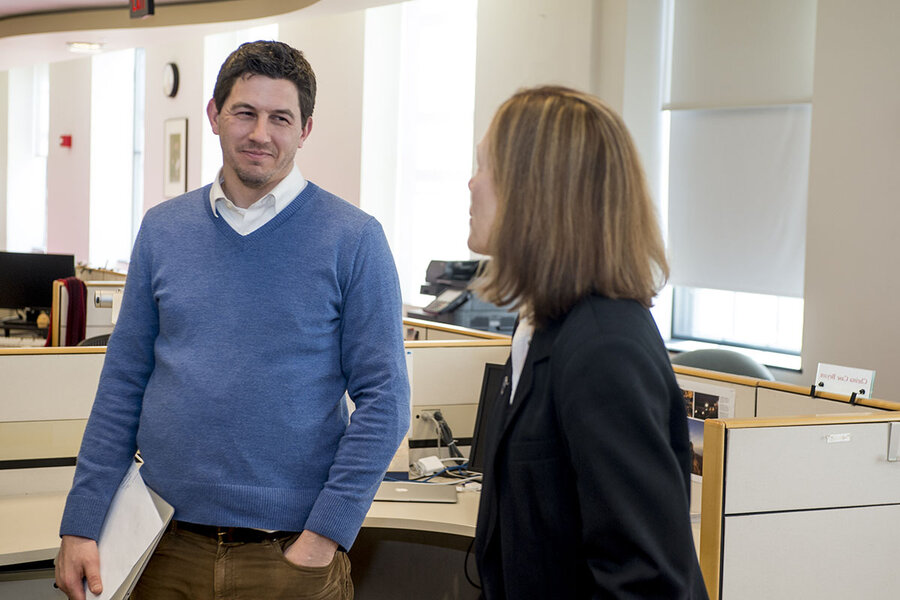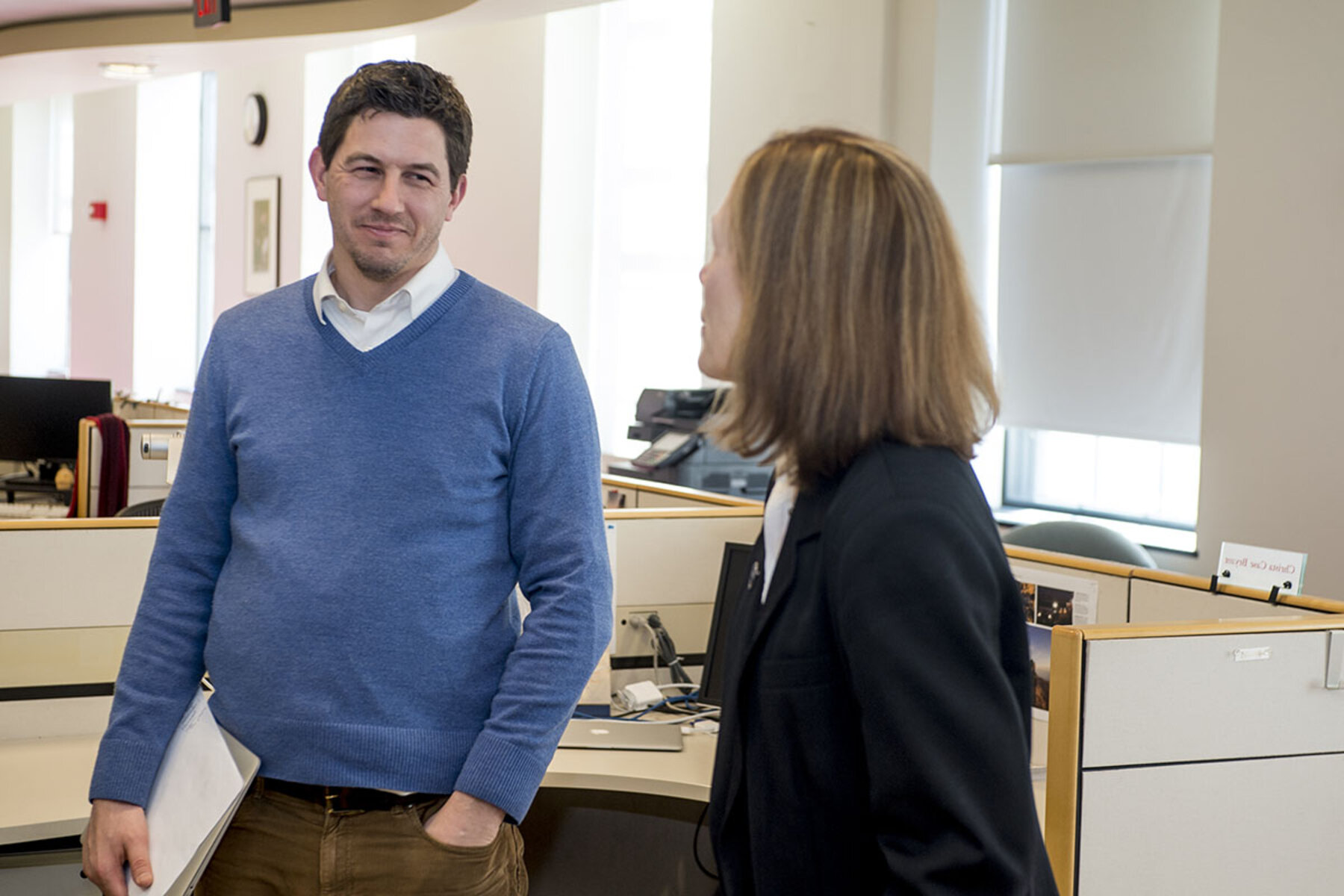
News for humanity: What a focus on ‘values’ really means
Reading the news today can leave people despondent and news-avoidant. We spoke to the Monitor’s editor about an approach that can be a balm – one that can uplift, unite, and help people feel agency.
In reporting the news, facts matter. But news is about more than facts.Ã˝
For this second episode of¬Ýour new podcast, host Samantha Laine Perfas spoke with Mark Sappenfield, the Monitor‚Äôs editor, to get a high-altitude view of the Monitor‚Äôs latest ‚Äúsharpening‚Äù of the solutions-oriented journalism it has practiced since its founding. It‚Äôs a heady approach, but one that‚Äôs grounded.Ã˝
‚ÄúThere are massive challenges for us to face as humanity. But if we only focus on the negative parts of that, we‚Äôre actually missing a huge part of the story,‚Äù¬Ýsays Mark.Ã˝‚ÄúIf you really focus on what matters in the news, you get to this idea that values are driving the news.‚Äù¬Ý
∫£Ω«¥Û…Ò like dignity, compassion, and respect are what drive humanity forward, he says. When reporters and editors take a values-first approach to their work, it fundamentally shapes stories and makes the news constructive. It energizes a populace rife with ‚Äúnews avoidance,‚Äù suffering from burnout and the constant focus on negative world events. This doesn‚Äôt mean that the news should only be positive, but rather it should paint a fuller picture of what‚Äôs happening beyond the problems.
“Human beings need a sense of agency, not only in their own lives, but in reading about other parts of the world,” says Mark. “And one of the things that I hope the Monitor can do is [show] that news doesn’t have to be [hopeless] – that you can look at the news and see agency.”
Show Notes
To read Mark Sappenfield‚Äôs recent column on the Monitor's new approach to the news, visit here.Ã˝
To explore the Monitor‚Äôs new ‚ÄúNews and ∫£Ω«¥Û…Ò‚Äù hub, go here, and share feedback at¬Ýeditor@csps.com
Here are some recent stories that Mark found to be good examples of our approach, with his take on why:
• The situation for Brazil’s Indigenous population is stark. This story doesn't shy away from that, but it comes at the topic though a lens on empowerment, looking at how Indigenous leaders are driving transformation.
• The topic of women’s rights in India can be a bracing story, fraught with sexual crime, gender selection, and remnants of patriarchy. But here we look at how a group of women is finding agency, and though that, dignity, all while making environmental change.
• The dominant narrative worldwide is the fragility of democracy, and that is a crucial story to follow. But when you look deeply, you see the inherent flaws of autocracies coming to the surface, too, offering nuance and basis for hope.
• The portrait from Jordan’s refugee camps is difficult – a picture of a people forgotten. Yet within the camps, there is still the light and hope that can be the seed of change if given a chance.
Episode transcript
[MUSIC]
Samantha Laine Perfas: Welcome to ‚ÄúWhy We Wrote This.‚Äù I‚Äôm your host, Samantha Laine Perfas.Ã˝
Today I‚Äôm joined by the Monitor‚Äôs editor, Mark Sappenfield. Mark joined the Monitor in 1996 and has since written from Boston, the San Francisco Bay area, the Pentagon, and South Asia. After returning to Boston in 2009, Mark served as both deputy national news editor and national news editor before taking on his current role. Today, he‚Äôs here to talk about a new way that the Monitor is approaching its coverage. Welcome, Mark.Ã˝
Mark Sappenfield: Hello, Sam.Ã˝
Laine Perfas: So you wrote an essay recently about how the Monitor is taking a new ‚Äúvalues‚Äù approach to its coverage. Can you talk about that a little bit?¬Ý
Sappenfield: Sure. We‚Äôve been doing amazing journalism for a long time. We try to go beyond just telling you facts. We try and help people understand why something matters or what it means. We try and connect dots. We want to recognize that there are ways to do the news, whether it‚Äôs the tone that we take or whether it‚Äôs the subjects that we look at, that fundamentally try and drive society forward, that look for the good, that look for where people are trying to make a difference. What we found is if you really focus on what matters in the news, you get to this idea that values are driving the news. And what I mean by that is people are fighting for something, for justice or for equality or fairness, or there‚Äôs questions deeply about responsibility in society. When you look at humanity, you‚Äôre talking about the fundamental ideas of dignity, of compassion, of respect. All of these things are really what drive us as humans and really what drive the news. And you realize if you just get to that level, it does something almost alchemical. It brings things to the surface. It helps with readers‚Äô understanding. It fundamentally makes it constructive. And it also takes news to that human level where we can all understand that common humanity that we share.Ã˝
Laine Perfas: We‚Äôve been talking about this being a new approach for the Monitor, but is it really that different than how we‚Äôve been doing journalism for the last hundred-plus years?¬Ý
Sappenfield: The way we‚Äôre thinking about it is: It‚Äôs a sharpening. These sorts of things have been kind of latent in our journalism, as you said, for as long as we‚Äôve been. And again, in this moment of journalism, there‚Äôs so much competition that you really have to be clear about who are you and why are you different and why are you important in the news media landscape. And so this is just taking those things that we feel have always been natural to who we are, native to who we are, and just making them plain or bringing them to the surface. It‚Äôs about us, you can almost say, valuing ourselves more, saying, ‚ÄúHey, this, we do do something a little bit different.‚Äù Let‚Äôs lean in on that. So how do you do this? So, you know, obviously, journalism is a lot about going out and looking and seeing what you see. And so often we see in journalism what people see are the negative things. It really does come down to a question of when you go out, what do you see ‚Äì these stories of values and of agency, I would say pretty categorically, are there to be found. You just have to condition yourself. You have to prepare yourself, understand how to look for them. To my knowledge, no one has ever done this approach to journalism before. So we as a newsroom are trying to figure it out. And that means all of our journalists coming together, trying to look through that lens. And then we come back to the newsroom and we talk about it. How did that go? Did that feel good? And we just keep calibrating. And it‚Äôs just a constant reinvention or reconsideration of, how do we sharpen this?¬Ý
Laine Perfas: Why are we doing this now?¬Ý
Sappenfield: I do think there‚Äôs a particular need to do it now. And there was an article that was written in The Washington Post not too long ago. It‚Äôs from ... her name is Amanda Ripley. And she talked about a trend that pretty much everyone in news is seeing at the moment. And you could kind of distill it as ‚Äúnews avoidance‚Äù or people being news avoiders. And the point that Amanda made is that ultimately journalism right now can leave you feeling sapped of your humanity, scared, angry, frustrated, all of these things. She says, what we need is ‚Äúnews for humans.‚Äù And what she‚Äôs talking about there, I think, is just this idea of: Human beings need a sense of agency, not only in their own lives, but [also] in reading about other parts of the world. We don‚Äôt want to be despondent. We don‚Äôt want to be hopeless. But news in general would seem to kindle those things. And one of the things that I hope the Monitor can do is we‚Äôre showing that news doesn‚Äôt have to be that way, is that you can look at the news and see agency.Ã˝
Laine Perfas: One thing this makes me wonder, Mark, is if there‚Äôs concern that our coverage might come off as only covering positive news and ignore some of the pretty terrible things that are happening in the world. How would you address that concern?¬Ý
Sappenfield: You know, that‚Äôs something that has been kind of thrown at us, certainly for my entire Monitor career. You know, ‚ÄúOh, is this rose-colored-glasses news?‚Äù And there was this wonderful quote. It‚Äôs the author of ‚ÄúCry, the Beloved Country,‚Äù which is a novel about apartheid in South Africa. And the author‚Äôs name is Alan Paton, and he was a big Monitor fan. And he says it is ‚Äúa paper of sober and responsible hope.‚Äù There are massive challenges for us to face as humanity. But if we only focus on the negative parts of that, we‚Äôre actually missing a huge part of the story. And that‚Äôs going back to Amanda Ripley‚Äôs point. That‚Äôs our agency. Despite all of these things, we have agency to change the world. We have the ability to improve the world. Not only do we have this ability, we use it. So my sense is, this is not Pollyanna-ish. It‚Äôs just a fuller view of what the news is.Ã˝
Laine Perfas: So to now ask you a question that‚Äôs maybe a little more personal, maybe not. As the Monitor‚Äôs editor, what makes you the most excited about this new approach?¬Ý
Sappenfield: One of the things that‚Äôs come to me is that at various times I think the Monitor has been an important voice and an important influence in helping to drive journalism toward a better sense of itself. You know, when the Monitor was first founded, you had yellow journalism and the Monitor helped overcome that. Then after that, the Monitor really pushed out and broadened its journalism to incorporate international journalism. The third wave was really about analytical journalism. It was about connecting dots. And that analytical wave, that third wave is what we‚Äôre still in now. So the question is: What is the fourth wave going to be? And to me, the next iteration is going to be journalism that is more constructive, just recognizing that the influence that we have on society matters and are we using it to uplift, using it to try and empower? Are we using it to look for solutions? Are we using it to use a tone that welcomes all and is respectful and doesn‚Äôt make enemies of people? And I feel like this values approach is our way of doing that. Mrs. Eddy said when she founded the Monitor, she said the object of the Monitor is ‚Äúto injure no man but to bless all mankind.‚Äù And I feel like that‚Äôs exciting. If you can do journalism that genuinely helps society, heals society, blesses society, makes things better, that‚Äôs pretty powerful and very exciting.Ã˝
[MUSIC]
Laine Perfas: Well, thank you so much, Mark, for sharing your thoughts on this.Ã˝
Sappenfield: Thank you.Ã˝
Laine Perfas: Thanks for listening. To find a transcript of this episode and our show notes visit csmonitor.com/whywewrotethis. This episode was hosted and produced by me, Samantha Laine Perfas, edited by Clay Collins. Our sound engineers were Tim Malone and Alyssa Britton, with original music by Noel Flatt. Produced by the ∫£Ω«¥Û…Ò Science Monitor. Copyright 2022.Ã˝
[END]
